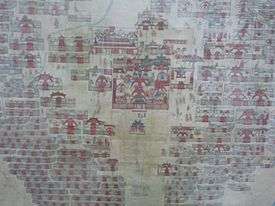Chinggis Square
| Chinggis Square | |
|---|---|
| Public square | |
| Mongolian: Их эзэн Чингис хааны нэрэмжит талбай | |
|
Panorama of Chinggis Khaan Square looking east | |
| Surface: | concrete |
| Location: | Ulaanbaatar, Mongolia |
| Coordinates: 47°55′08″N 106°55′03″E / 47.91889°N 106.91750°E | |
Chinggis Square (Mongolian: Чингисийн талбай, pronounced Chinggisiin Talbai), formally Grand Chinggis Khaan Square, and previously known as Sükhbaatar Square (Mongolian: Сүхбаатарын талбай, pronounced Sükhbaatariin Talbai), is the central square of Mongolia's capital Ulaanbaatar. The official name was changed in 2013 in honor of Genghis Khan, considered the founding father of Mongolia.[1] The city's residents still refer it by the original name.[2] A large colonnade monument to Genghis Khan, as well as to Ögedei Khan, and Kublai Khan dominates the square's north side directly in front of the Saaral Ordon (Government Palace). The center of the square features an equestrian statue of Damdin Sükhbaatar, one of the leaders of Mongolia's 1921 revolution.
Buildings
Government Palace (built in 1951 on the spot formally occupied by the national theater or "Green Domed Theater") is located on the north side of the square. It is fronted by a large colonnade monument to Genghis Khan, Ögedei Khan, and Kublai Khan, completed in 2006 in time for the 800th anniversary of Genghis Khan's coronation. Prior to its demolition in 2005, Sükhbaatar's Mausoleum, the former burial place of Damdin Sükhbaatar and Khorloogiin Choibalsan occupied the area just in front of the Government palace. On the square's western side sits the headquarters of the Ulaanbaatar Bank, Ulaanbaatar City Administration building, the headquarters of Golomt Bank, the Mongolian Stock Exchange building (formerly the Eldev-Ochir Cinema: 1946–1948), the Mongolian Telecommunications Building, and the Central Post Office. The eastern side of the square is flanked by the Central Cultural Palace Building and State Ballet and Opera House, built between 1946 and 1949, and the Central Towers, a glass and metal skyscraper completed in 2008. To the south sits the old Lenin Club building (built in 1929 located right next to the modern sail shaped skyscraper, Blue Sky Tower.
Besides the Sükhbaatar monument in the center of the square, several other statues dot the square including one of former president Jamsrangiin Sambuu on the north-western corner, and another for slain revolutionary leader Sanjaasürengiin Zorig across the intersection on the south-western corner (in front of the Central Post Office).
History

The grounds of the present day government palace and public square were largely occupied by the monastery and temple complex of Ikh Khüree in the late 19th and early 20th centuries. This central temple-palace complex was the largest and oldest section of Ulaanbaatar, and was called the Zuun Khuree or Eastern Monastery. An open air field was located just south of the temple complex and was surrounded on all sides by temples, residences of the nobility and clergy as well as the Baruun Damnuurchin markets. Mongolian wrestling and Tsam dances were often staged there in the presence of nobles and clergy. Over time, it devolved into a dumping ground of the growing city's refuse. The Bogd Khan would sometimes be seen passing along its edge on his royal procession to the Yellow Palace in the Ikh Khüree temple-palace complex.
The temple-complex was razed shortly after the Outer Mongolian Revolution of 1921 and was replaced with the National Theater, also known as the "Green Domed Theater", in 1926. The theater was destroyed by fire in 1949. Mongolia's leader Khorloogiin Choibalsan then ordered the construction of the Government Palace on its site in 1951.
The square was named in honor of the Mongolian revolutionary hero Damdin Sükhbaatar shortly after his death in 1923. The newspaper "Izvestiya Ulanbator khoto" reported on July 15, 1925 that "in line with Mongolian tradition the fourth anniversary of the People's Revolution was celebrated with rallies at the square dedicated to D.Sükhbaatar". The current statue of Sükhbaatar upon his horse was created in 1946 by the sculptor Sonomyn Choimbol (1907-1970) and is located on the spot where his horse allegedly urinated during a rally on July 8, 1921, shortly after the victory of the 1921 revoluation. Sükhbaatar's horse urinating was seen as a good omen and a marker was buried on the spot by a man called "Bonehead" Gavaa. Marshal Khorloogiin Choibalsan (who participated as a simple worker during the cementing process of 1946 along with Yumjaagiin Tsedenbal) had the marker dug out and chose the spot as the place of Sukhbaatar's statue.
Events

During Mongolia's socialist period, Sükhbaatar Square was the scene of annual civil, youth, and military parades until 1989, with party and government leaders ascending to the top of Sükhbaatar's Mausoleum to view parades on May 1, July 11, and November 7 each year. Large parades were also staged for important visitors, such as when Brezhnev made an official visit to Mongolia in 1966. The square was the focal point of the Democratic Revolution of 1990 where massive demonstrations and hunger strikes took place. Sükhbaatar Square was also the scene of the violent riots on July 1, 2008 when 5 people were shot dead and many more injured while protesting parliamentary election results. Today, the square is still the scene of major state ceremonies, cultural events, and exhibitions. Heads of state of foreign countries generally pay respects in front of the statue of Sükhbaatar.
References
- ↑ English News. MN. "Sukhbaatar Square to be renamed after Chinggis Khaan". http://english.news.mn/content/151247.shtml. External link in
|website=(help); - ↑ "Chinggis Khaan (Sükhbaatar) Square". http://www.lonelyplanet.com/mongolia/ulaanbaatar/sights/squares-plazas/chinggis-khaan-sukhbaatar-square. External link in
|website=(help);
External links
![]() Media related to Chinggis Square at Wikimedia Commons
Media related to Chinggis Square at Wikimedia Commons